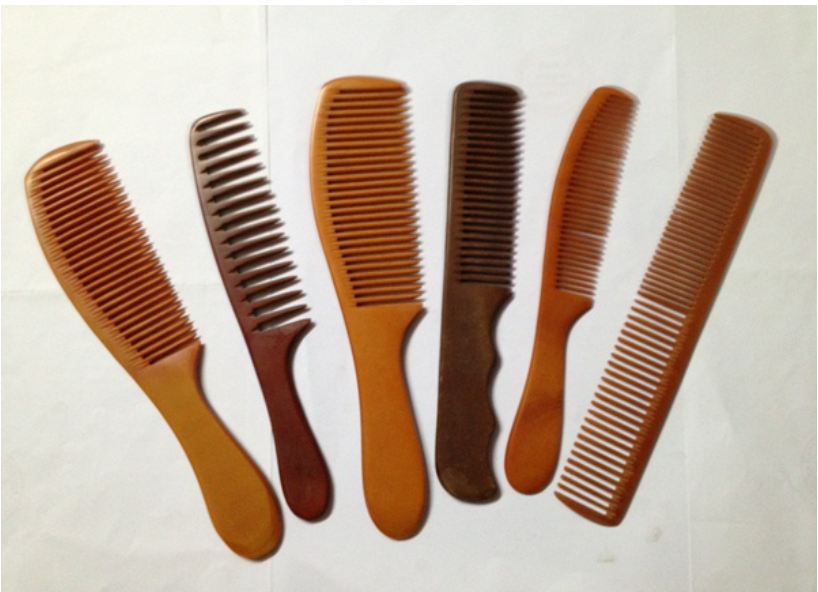Xom Luoc and the craft of making horns
Xom Luoc is the common name of the villages Phuoc Long (Tinh Ha commune), Phuoc Tho (Tinh Son commune), An Thiet (Tinh Binh commune), Van Hoa (Tinh Tho commune) in Son Tinh district, Quang Ngai province.
Although located in 4 communes, these villages are adjacent to each other and because the people have the profession of making hair combs (and a number of other handicraft products) from buffalo horns, they have the same folk name, Luoc hamlet. Exactly, only 3 villages, Phuoc Long, Phuoc Tho, and An Thiet, do this profession. Van Hoa Village specializes in providing raw materials and purchasing products for resale throughout the province and country.
The legend about the three brothers Mr. Xa (Mr. Xa, Mrs. Ta, Mrs. Hop) is still circulating in the area, saying: After bringing people here to explore and establish a village, Mr. Xa encouraged them to take care of their crafts. Work like making hats and making horns to help plow the fields and take care of food and clothing. Mr. Xa Rom fought against the Imperial Court but failed, and had to suffer the penalty of self-“ascension” with 7 meters of cashew silk; However, the craft of making horns and making hats is still passed down to this day.

Look out at the world
Xom Luoc currently has about 60 households involved in horn making, of which there are about 20 professional households (almost no farmers); The remaining nearly 40 households only work during leisure time, or at night. The number of skilled artisans is more than 60 people, the number of skilled artisans can make unique, aesthetically pleasing products (worship objects, Chinese chess…), there are less than 10 people, most of them are elderly. .
Without seeing it with your own eyes, it is difficult to imagine how from buffalo horns, craftsmen create dozens of products that are both durable and beautiful like all kinds of combs (thick combs, thin combs, specialized combs). used for barbers, folding combs), women’s hair pins, chess pieces of all kinds, decorative statues, altar items, pens, belts, eyeglass frames, women’s jewelry boxes…
Horn making is one of the few crafts in which the craftsman must use many tools and go through many processing stages to get the finished product. For example, to make a hair comb, a craftsman needs at least 9 types of tools, including: Saws of all kinds (5 sizes), presses (to press horns into blocks), planers (10 different blade sizes). each other), photography (to size the comb teeth), grinding (to fix the plane blade), grinding (adjusting the saw line), chisel, shackle, engraving knife…

From rough buffalo horn to a beautiful comb, one must go through a series of stages: First, use a saw to cut the horn lengthwise in different sizes. Next, heat the horn evenly over the fire until it softens so that it can be put into dough and pressed into blocks. On the pressed horn block, people use a knife and photographer to mark the size corresponding to each product. After sizing, use a saw and saw to “cut out the horn”. Horn pieces of this size are planed until they are even and smooth before being graded, then using a very thin and sharp saw to “cut the teeth” evenly to become a preliminary comb. Pre-processed combs must be re-toothed, carved and polished to get a finished product satisfactory to the user.
A class 1 thick-toothed comb, used for ladies and girls, is about 9 centimeters long and 5 centimeters wide. This comb cuts 2 rows of teeth along the 2 long edges. Each row has about 100 evenly spaced teeth. It’s a feat but also very skillful. These are just “average” products compared to unique products such as fountain pen covers, Chinese chess pieces, candlesticks, incense bowls or decorative animals (elephants, buffaloes, crabs, lobsters… .).
People say that, during the resistance war against the French (1945-1954), Luoc hamlet was the place that produced and supplied famous beautiful horn pens to teachers and students of Green Forest Resistance High School, located in the forest. Xanh, located a few kilometers west of Luoc hamlet.
According to artisans, from Nghe An to the South, there is no horn making profession anywhere. Therefore, the products they make (mainly combs) are sold by comb sellers (in Van Hoa village, Tinh Tho commune) to the South, Central Highlands, Southern Laos, and Cambodia. Some comb sellers also buy raw horns from Chau Doc, Long Xuyen, and Bay Nui to supply to producers.
The number of artisans who can create unique, artistic products as mentioned above is very small, most of them are elderly people. They only make products to maintain their ancestors’ karma or according to orders from some people who like to play with handicrafts. There are many middle-aged people who are skilled at their jobs, but because of low income, not many people pursue the profession.
Like many other traditional handicrafts, the current difficulty of horn making is related to capital, raw materials, the worker’s ability to diversify products and the consumer market.
https://www.amazon.com/s?k=comb&crid=C7NE6OQDBTMG&sprefix=comb%2Caps%2C615&ref=nb_sb_ss_ts-doa-p_1_4
The products of horn making are beautiful, the price is not high, many people like to use them, but for a long time they have only been sold in rural markets or sold around working-class villages in urban areas, so the quantity consumed is not much and very slow. Sophisticated products (horn flags decorated with mother-of-pearl, altar objects, animals…) that can proudly appear in luxurious interiors or in the collections of those who enjoy fine arts, are rarely seen. introduction should be almost forgotten.
The craft of making horns in Luoc hamlet is in danger of disappearing, with a lot of precious folk knowledge passed down from generation to generation gradually falling away over time. Although the comb makers are passionate about their profession, they have to wander abroad for food and clothing. Maintaining the karma of our ancestors, mostly elderly people, close to home and far away from heaven.
Nurturing the worker’s love for his profession and making him live with his profession are two sides of the same problem that need to be resolved satisfactorily and synchronously to find a solution to the problem of restoring the craft village of Luoc hamlet.
Looking across the country, Thuy Ung horn comb craft village (Hoa Binh commune, Thuong Tin district, Hanoi) was once at risk of being lost, but in recent years, with the attention of the government, many craftsmen have determined to preserve and restore the ancestral profession. They have researched the market, found a way out for traditional combs, and tinkered with ways of making and designing to have more beautiful, affordable combs. Products of Thuy Ung horn craft village are popular all over the country and exported abroad, becoming extremely unique handicraft products of Vietnam.
Lessons from Thuy Ung are very necessary for the craft village of Luoc hamlet!
Vietnam American Trade Promotion Association – Center to support the export of handicraft goods and promote craft village goods to the US market
Address: 143 Nguyen Tuan – Thanh Xuan – Hanoi
Southern Transaction Office – 142 Nguyen Cong Tru – District 1 – HCMC
Email: vietexport123@gmail.com
Tel: +84 03 66 33 66 33
SUPPORT PROMOTION AND PUSH PRODUCTS TO THE WORLD WITH MAKYN GROUP
GLOBAL SALES PROMOTION
GLOBAL LINK WITH AMAZON
STANDARD EXPORT GOODS LICENSE
MARKET POSITIONING AND PROVIDING CERTIFICATIONS
CONNECTING PARTNERS AND EXPORT SOLUTIONS
SUPPORT AND RECEIVE GOODS BELONGING TO PRIORITY CRAFT VILLAGES


 Tiếng Việt
Tiếng Việt